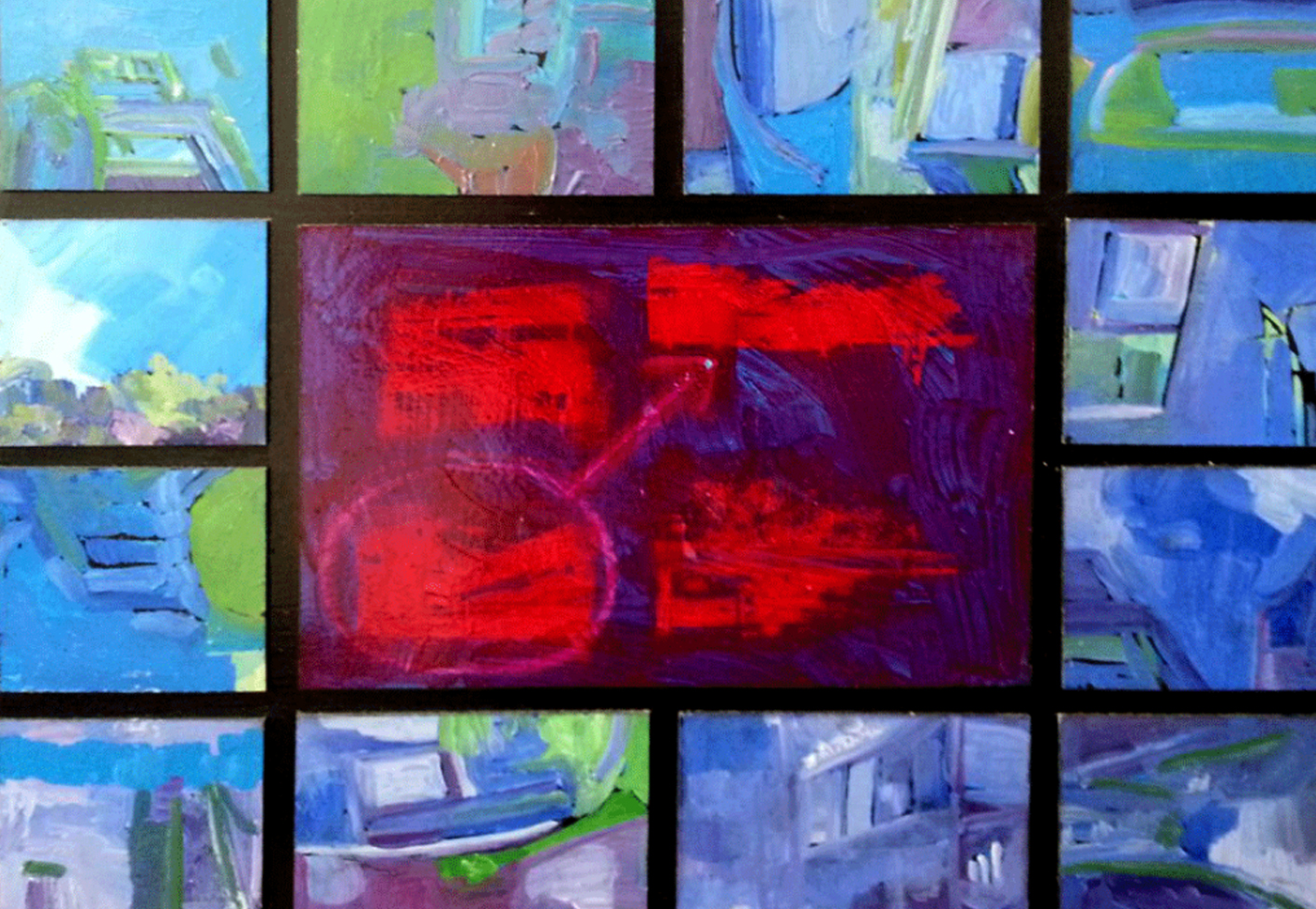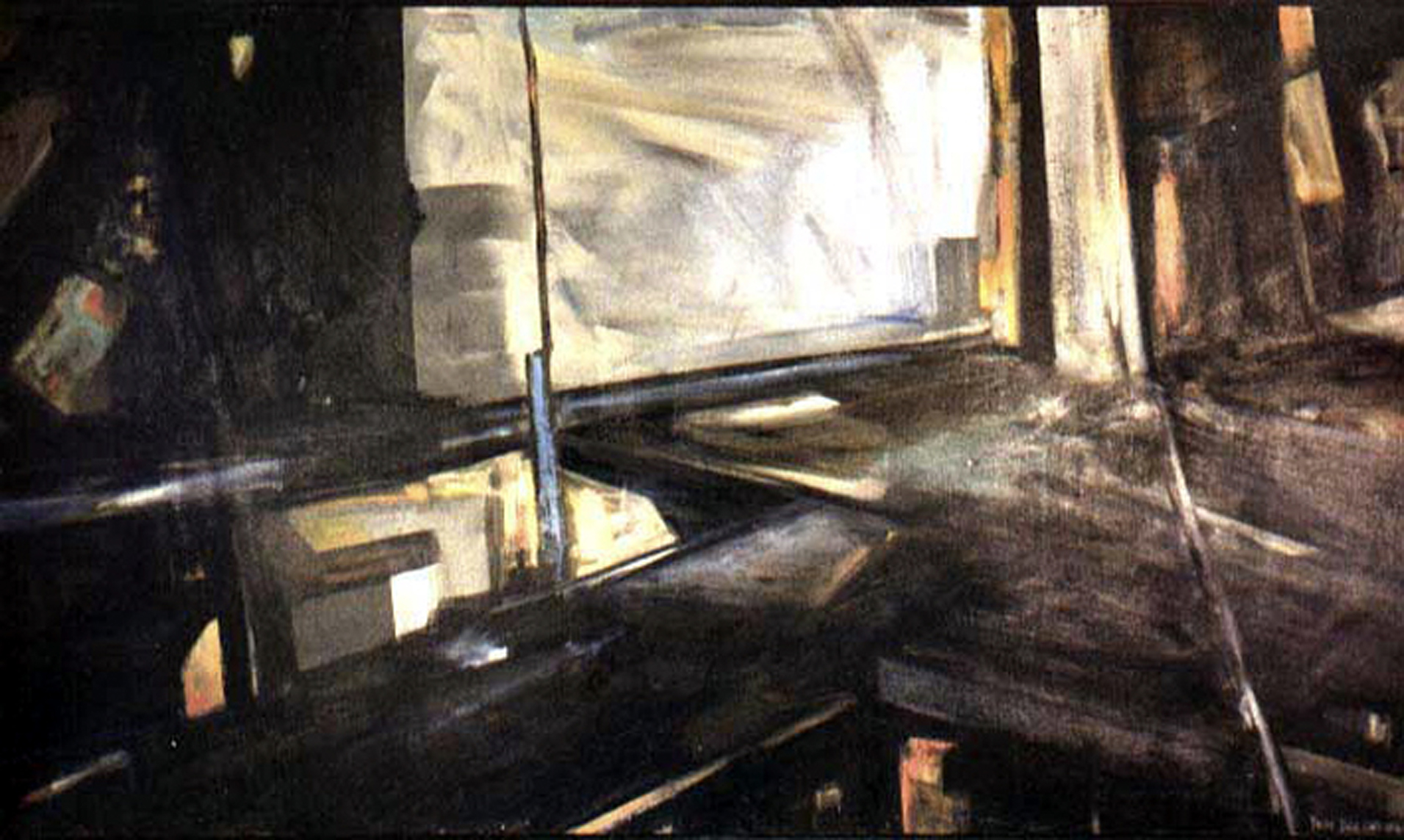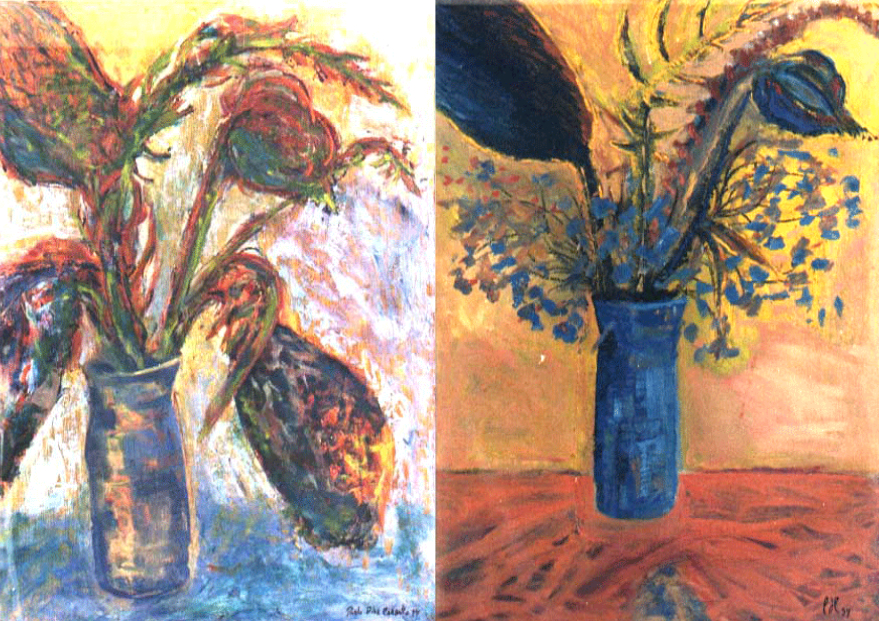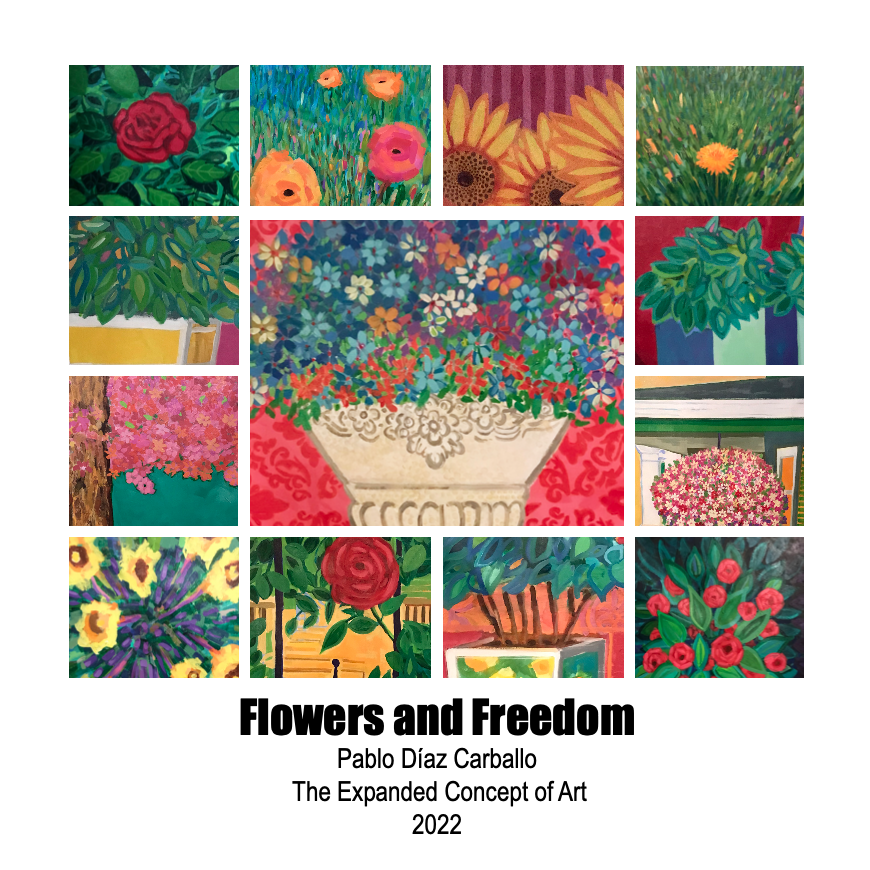All rights reserved
Pablo Diaz Carballo
2024
The House of the Mind
CATALOGS
Original Contemporary Art: Paintings. Artist representative, Michael Kirby – Phone to +1 (785) – 491.0576, Director@pablodiazcarballo.com
Graphic Archaeology

Graphic Archaeology Pilot Project
Ideo Arte – The Project Timeline

The House of the Mind: a conceptual art painting of the decision-making process. 1.- Exploration in multiple directions: represented by the left and right windows. 2.- Decision and Effort: symbolized by climbing stairs. 3.- Leap into the void: illustrates the final choice or decision.
Hermeneutics: Reconstruction

“The Three Windows of Consciousness” (1999) “The Three Windows of Consciousness: Reconstruction” Thomistic Interpretation of Art (2021)

Magisterium: Hermeneutics of Hermeneutics

“The Hermeneutics of Architect Carlos Raúl Villanueva – U.C.V.”

Lyrical abstraction

Critical Analysis of Pablo Díaz Carballo’s Paintings
Composition and Structure:
Díaz Carballo’s abstract compositions feature intertwining geometric shapes and angular lines, creating spatial depth and guiding the viewer’s gaze. His early works use blue and grey tones to evoke architectural elements like windows.
Use of Color:
Expressive color dominates his work. Blues, greys, and blacks create a contemplative atmosphere, occasionally disrupted by warm reds for tension. High-contrast palettes enhance the structural and dramatic quality of his paintings.
Texture and Technique:
He employs visible brushstrokes and layered paint to add tactile depth. Earthy tones and gestural techniques reinforce the emotional intensity, blending materiality with expressive detail.
Symbolism:
Windows and structures serve as metaphors for introspection and perception. His works explore dualities—natural vs. constructed, organic vs. artificial—inviting deeper reflection.
Conclusion:
Díaz Carballo’s paintings masterfully blend form, color, and texture to evoke an introspective and poetic experience, encouraging viewers to uncover complex emotions and ideas within his art.
Summary of “Flowers and Freedom” Series by Pablo Díaz-Carballo
The conceptual series Flowers and Freedom by Pablo Díaz-Carballo, linked to his metaphor of the House of the Mind, explores the transformative potential of art and creativity within the inner world of the mind and spirit.
Visual and Conceptual Themes:
- First Painting (The Soul):
This piece uses dark tones with contrasts of light and shadow to symbolize introspection and the struggle to break through mental barriers. The interplay of darkness and light represents a journey from psychological confinement to clarity, where light becomes a metaphor for divine knowledge and freedom. - Second Painting (Garden):
In contrast, this vibrant work depicts a colorful field of flowers symbolizing mental liberation. The dynamic brushstrokes convey continuous growth, with the central red flower emphasizing individuality and divine presence in creation. This piece celebrates the flourishing of thoughts and emotions in a creative, liberated mind.
Conceptual Link:
Together, these paintings depict a progression from internal struggle to expansive freedom, visually illustrating the House of the Mind metaphor. Díaz-Carballo emphasizes that true freedom is not just overcoming barriers but fostering creativity and transformation within.
Overall Significance:
Flowers and Freedom celebrates the human capacity for inner growth and the role of art in unlocking this potential. The series is both a reflection on personal spiritual exploration and an invitation to recognize divine beauty in creativity and nature.
Flowers and Freedom
Conceptual Analysis Framework: “My neighbors spend a lot of time taking care of the flowers in their garden. Mrs. Moats is an artist in the process of planting and caring for various flowers to create a true work of art in the large garden of her house, which could be indirectly related to the artists of the Land Art movement. In the spring, Mrs. Moats had worked for weeks and had already finished all the work in the garden, but the weather in this state is unpredictable; suddenly, an unexpected snowfall fell and in one night ruined all the flowers. At that moment, I realized the metaphor between the beauty and fragility of flowers and the beauty and fragility of freedom. Freedom is not free; to maintain those privileges, proactive citizens are needed in their communities, like gardeners, to maintain the system that gives us the privilege of living in freedom.”

GARDEN
Click over the image below and go to the online shop:
Summary of Pablo Díaz Carballo’s Painting Analysis
Composition and Structure:
Díaz Carballo’s painting features a vibrant floral arrangement in a decorative vase, centrally positioned on a pedestal. The detailed, symmetrical vase contrasts with the organic flow of the flowers, creating a balance between order and natural beauty. A red, patterned background enhances depth and complements the composition’s luxurious feel.
Use of Color:
The artwork employs a rich palette of blues, purples, oranges, greens, and whites for the flowers, contrasted by the neutral tones of the vase. The warm red background intensifies the vibrancy of the flowers, creating an emotionally charged interplay between cool and warm tones.
Texture and Technique:
The artist’s meticulous detailing brings texture to life, from the tangible solidity of the vase to the fluid brushstrokes capturing the movement of flowers. The textured background adds richness, highlighting Díaz Carballo’s skill in blending permanence with ephemeral qualities.
Symbolism and Interpretation:
This piece reflects on the fragility of beauty and the transience of life. The flowers symbolize love, nature, and the delicate balance of freedom, while the vase suggests the need to nurture and protect these fleeting aspects. A metaphor involving snowfall destroying a garden underscores the vulnerability of social values.
Conclusion:
Díaz Carballo’s painting marries technical precision with symbolic depth, inviting reflection on the impermanence of beauty and the effort required to safeguard societal freedoms. It is a celebration of nature’s elegance intertwined with profound social commentary.
Click over the image below and go to the online shop:
Bottles
Click over the image below and go to the online shop:
This critical analysis examines an artwork centered on bottles, exploring various artistic elements and their potential meanings.
Composition and Structure: The artist arranges a collection of bottles—such as water, wine, or empty bottles repurposed as vases—creating a still life composition. These bottles vary in positioning, some with flowers, adding balance and rhythm to the artwork. This arrangement reflects the tension between utility and aesthetics, perhaps commenting on how objects, traditionally viewed for function, can hold deeper visual and conceptual value.
Use of Color: The color palette blends earthy tones representing glass with bright floral colors, creating a dynamic play of light and shadow. Transparent or semi-transparent bottles interact with their surroundings, offering changing hues depending on lighting. The colors evoke different emotional tones: subdued colors may suggest introspection or melancholy, while vivid hues convey energy and life, engaging the viewer both emotionally and visually.
Texture and Technique: The artist contrasts textures, from the smooth glass of the bottles to the softness of flowers and the roughness of bottle labels. The technique may range from precise to expressive, highlighting the delicate balance between organic elements and manufactured forms. This textural interplay emphasizes the physicality of each object, prompting reflection on the tangible qualities of the depicted items.
Symbolism and Interpretation: Bottles, often associated with containment or consumption, gain new meaning here. Water bottles might symbolize life and sustenance, while wine bottles represent celebration or indulgence. Empty bottles transformed into vases might symbolize transformation, renewal, and beauty found in the mundane. The flowers serve as symbols of resilience and life flourishing in unexpected places. The work might also explore environmental themes like recycling or the fleeting nature of material objects.
Conclusion: The artwork encourages a reexamination of ordinary objects through thoughtful composition, color, and texture. It challenges the viewer to see bottles not only as utilitarian items but as vessels for deeper symbolic meaning. Whether addressing mental issues, consumer culture, or the beauty of everyday life, the work invites the audience to reflect on the potential for new interpretations of the objects that surround us.
THE YELLOW TUTU

Five years dedicated to understanding reality according to Plato’s concept of ‘kalokagathia’ and the House of the Mind.”
Historical Archive artworks sold to public and private collections
Willemstad, 2014 – 2018
Architecture if the Mind
Caracas, 1999 – 2014


Two Perspectives, One Object: Subjective Variations in Perception
The artworks by Pablo Díaz-Carballo presented here share an identical structure in figure and background, as both take the same visual reference as their subject: the U.C.V. However, through color and the interpretation of lines, Díaz-Carballo invites us to explore the profound differences that emerge when subjective perception comes into play.
In both images, the physiological and optical perception of the human eye remains constant; the observed object is unchanging in its physical essence. Nevertheless, the chromatic and expressive variation arises from a deeper level: subjective hermeneutics. It is here that factors such as culture, education, memories, and personal meanings come into play, shaping the interpretation of each viewer.
Díaz-Carballo envisions this interaction as if each individual could wear a visor connected to a system that graphs, in real time, the variations in subjective perception of the same object. This conceptual approach underscores that each image is a reflection of human diversity, a representation of how individual experiences influence our way of interpreting the world.
By presenting these two artworks side by side, the artist highlights not only the universality of the observed object but also the richness of the interpretations derived from it. He invites us to reflect on how each gaze is an act of creation in itself, a unique dialogue between the observer and the observed.
Visual and Conceptual Analysis:
Central and Peripheral Composition:
The composition is arranged in a grid, with a central, larger image surrounded by smaller peripheral ones. This layout emphasizes that the central image represents the primary “gaze” of the subject, while the peripheral images serve as “attacks” or influences on this gaze. The use of vibrant colors, especially blue and red, in the central image conveys emotional intensity or conflict, symbolizing the struggle between objective perception and subjective influences like memory and culture.
Peripheral Images and Memory:
The peripheral images are darker and less defined, symbolizing the fragmented and elusive nature of memories. The color palette varies, ranging from greens to muted blues, suggesting different emotional states or experiences that interfere with the central perception. This variation can also represent the accumulation of multiple interpretations that shape how we perceive an object or scene.
Symbolism of Forms and Spaces:
The central image features geometric shapes resembling architectural structures, such as lines evoking a path or perspective. This architectural symbolism may represent the construction of perception and interpretation through cultural and memory frameworks. The overlapping red and blue lines could symbolize the intrusion of emotions or memories that alter direct perception.
Dynamic Between the Physiological and the Subjective:
The contrast between the central and peripheral images reflects the tension between physiological vision (what the eye sees) and the layers of subjectivity imposed by memory and culture. Though the peripheral images are less visually intense, they hold significant symbolic power, suggesting that our interpretations are often influenced by past experiences and context.
Reflection on Interpretation:
The artwork invites viewers to question the nature of objective perception, suggesting that what we see is always mediated by a complex web of past experiences, emotions, and cultural learning. The structured grid format implies that, while our perceptions are subjective, they are still shaped by a pre-established framework.
Conclusion:
The piece is visually engaging and conceptually profound. It prompts viewers to consider how different individuals might interpret the same artwork in various ways, influenced by personal memories and cultural contexts. This adds another layer of interactivity and subjectivity to the work, reinforcing its central message.






The Poetry of the Mind
These two artworks evoke introspection and melancholy through color, light, and composition.
The first image features a dark interior scene with intense light in the background, creating a contrast between shadow and light. Dominated by blue and black tones, it suggests mystery or desolation. A door or window on the right symbolizes transition or hope, while the light diffusing into the space suggests a struggle between darkness and illumination, possibly representing internal conflict or a search for clarity.
The second image, set outdoors, contrasts light and darkness in a desolate, arid landscape. The light on the horizon, representing either sunrise or sunset, symbolizes moments of transition. The loose brushwork conveys the emotional energy of the scene, with a solitary structure reinforcing isolation.
Both works explore themes of time, transition, and the human experience amidst the unknown, with their stark contrasts between light and shadow reflecting existential concerns. Influenced by Conceptual Art, Expressionism, and Symbolism, the works suggest an introspective journey, urging viewers to reflect on their own existence and the complexity of finding meaning in a world often dark and disorienting.
The Hermeneutics of Critical Analysis

This work was presented at the Jacobo Borges Museum in Caracas and later at the T. Febres Cordero Cultural Center in the city of Mérida. It is an installation that includes an oil painting of a structure of the “House of the Mind” under construction, which is presumed to be a door. A sheet of diffuse acrylic was added to this painting, creating an effect of a cloudy atmosphere over the image.
Before placing the acrylic, when the painting was finished, Pablo Díaz-Carballo presented it to four art critics (professors from IUESAPAR) to have them provide their critical analysis of the work. The statements of these four critics were recorded and later added to the installation through a pedestal containing an audio player with the tape playing and headphones.
Subsequently, the installation was presented in the museum, which consisted of: the oil painting with an atmosphere of blue tones under construction, whose image appears diffused by the acrylic (representing the conceptual filters we have when looking at things: looking without seeing more than the concept that names things, but without contemplating their presence in the contemplative silence of the gaze), and at a certain distance, there was the pedestal with the audio and headphones.
In this way, the viewer heard an analytical explanation of an image they could not see clearly: the hyper-concept that obstructs the experience of the gaze.
This artwork was presented in an exhibition at the Ruta del Arte in Tovar, Mérida State. Both Jesús Soto and Carlos Cruz-Diez saw the work in the exhibition hall. It was acquired by Iván Edilio Vivas (RIP), President of La Ruta del Arte, and is currently part of his private art collection in the city of Tovar, estado Merida, Venezuela.



The Construction of Thought and Its Hermeneutics

Hermeneutics on a Timeline
Milan and Daria Brecht – Dr. Roberto de Vries

Academic exercises


The House of the Mind, the first Windows, 1994.







